Counter-Strike: Global Offensive developer Valve issued a record number of VAC bans through Steam in December, according to statistics site SteamDB.
Data pulled from SteamDB suggests that more than 611,000 VAC bans were issued last month. It’s a massive jump from Valve’s old VAC ban record, which was set at 193,000 bans in July 2018. SteamDB doesn’t specify what games the VAC bans were issued for, though the system is most often linked to CS:GO. It’s unlikely that all the bans were issued for the game, though the drastic increase does coincide with Valve’s decision to set CS:GO free-to-play. Dot Esports has reached out to Valve for more information.

CS:GO saw a huge jump in players, naturally, when the game went free-to-play in early December. From Dec. 2 to Dec. 3, the date the free-to-play update was posted, players rose 300,000. User numbers have since decreased slightly, but remained well above peak players before the free-to-play update.
Related: CS:GO becomes free-to-play as Valve introduces a battle royale mode, Danger Zone
VAC stands for Valve Anti-Cheat, which is a system designed to detect third-party cheating programs installed on players’ computers. Playing a game like Counter-Strike: Global Offensive, a multiplayer game, with a third-party program that gives a playing advantage will trigger the system. VAC bans are “permanent” and “non-negotiable,” according to Valve.
Banned players can still play single-player games, but are unable to access VAC-secured game servers. Games that are VAC-enabled include CS:GO, Team Fortress 2, Dota 2, Rust, DayZ, and many more. Separate from VAC bans, players can also be game-banned on Steam, which allows individual developers to ban disruptive players. Valve issued more than 800,000 game bans in December, which is far its peak in 2018; in July, Valve game-banned more than 1.6 million players, according to SteamDB.






Published: Jan 4, 2019 10:12 am